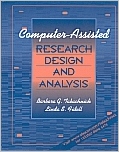| |||||
• polskie
• Zamów informacje o nowościach z wybranego tematu • kontakt |
COMPUTER ASSISTED RESEACH DESIGN AND ANALYSISTABACHNICK B.wydawnictwo: A&B, 2001, wydanie Icena netto: (Special Offer: Discount 75% of the price)
Computer-Assisted Research Design and Analysis is a textbook or reference book for people who have a background in basic descriptive and inferential statistics. Although we review basic descriptive statistics in Chapter 2 and the logic of basic ANOVA in Chapter 3, the reviews are slanted toward screening data and understanding the assumptions of analyses. In most universities, the book is appropriate for senior or first-year graduate study, or for those who are taking part in a year-long research design and statistics course. One distinctive feature of the book is the inclusion of the regression approach to ANOVA alongside the traditional approach. As we included more and more of the regression approach in our courses, we developed appreciation for the clarity and flexibility of this approach to ANOVA. The approach easily clarifies issues associated with unequal n and interaction contrasts, among others. It also greatly facilitates understanding of fractional factorials and other screening designs, which are the topics of Chapter 10. Although screening designs are not routinely included in a social science curriculum, they should be. They offer a powerful approach to pilot studies and an organized method of research for areas where few cases are available. With knowledge of how to set up a data set for the regression approach and the availability of regression software, you will learn to appreciate the full flexibility of ANOVA conducted through regression. Computer-Assisted Research Design and Analysis also includes details on how to perform both simple and complicated analyses by hand through traditional means, regression, and through the most recent (at the time of writing) versions of SPSS, SAS, SYSTAT, and MINITAB. Syntax and output for both basic and complicated analyses are shown, with interpretive comments of the output. Chapters 4 through 7 review basic and complicated analyses for randomized groups, repeated measures, and mixed designs.* Then we include illustrations of analyses for basic and complicated screening, Latin-square, ANCOVA, and nesting and random-effects designs. More material is included than some instructors may want to cover in depth in one semester, so instructors should choose the analyses most appropriate for their disciplines. However, because all chapters follow a similar outline, students can continue study on their own or readily find material they need when they encounter an unusual problem later on. We have used this book in manuscript form three times prior to publication. The first 10 weeks are used to cover material through Chapter 7 (mixed randomized-groups, repeated-measures designs). Students found the review of factorial designs at the end of Chapter 7 especially helpful. The remaining 5 weeks are used to cover the basics of ANCOVA, Latin-square, screening, and random-effects designs, and make students familiar with some of their complications. The first eight chapters comprise a fast-paced, one-quarter course. Chapters 4 through 11 follow the same format. The introduction is followed by the research questions that can be answered by the analysis and then by the major assumptions of analysis, with recommendations if there is a violation of an assumption. The next section has an unrealistically small and often silly data set that is analyzed by traditional methods, through regression, and through the four software packages. These examples reflect our hobbies (skiing, belly dancing, and reading primarily mystery and science fiction) and are meant to be immediately accessible to people from a variety of backgrounds. 789 pages
Księgarnia nie działa. Nie odpowiadamy na pytania i nie realizujemy zamówien. Do odwolania !. |


